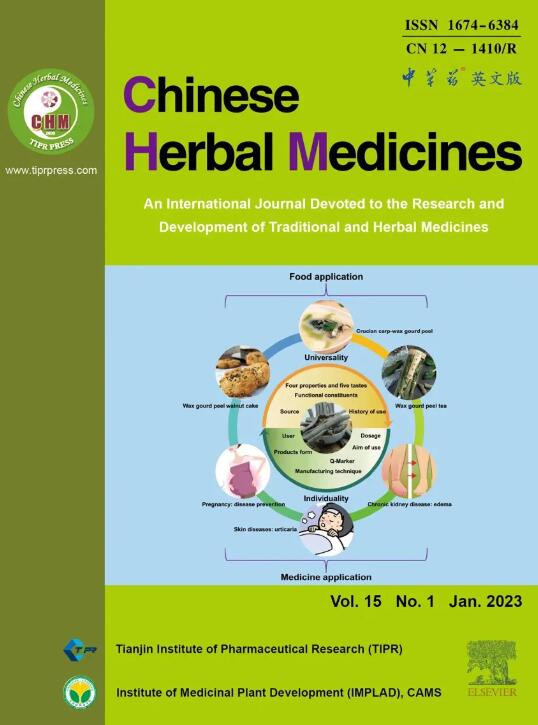草药化合物的系统发育和空间模式:哪些药用植物具有植物化学特征?
IF 8.9
4区 医学
Q1 CHEMISTRY, MEDICINAL
引用次数: 0
摘要
研究药用植物的植物代谢物及其系统发育分布是药物系统发育的重要内容。本研究的目的是对药用植物的植物化学研究程度进行最新估计,并将其与物种水平的系统发育及其地理格局联系起来。方法我们对 1 648 种植物代谢物(包括萜类、甾体、黄酮类、苯丙类、酚类、生物碱等)进行了进一步表征、这些植物代谢物包括萜类化合物、甾体化合物、黄酮类化合物、苯丙酮类化合物、酚类化合物、生物碱类化合物等。根据结构特征,将萜类、黄酮类、生物碱类和苯丙类化合物细分为亚类,首次在亚类和系统发育水平上对植物代谢物的研究工作进行了划分。结果表明,具有多种生物活性的萜类化合物仍是植物化学研究的主要对象,其次是黄酮类、酚类、苯丙类和生物碱类。在已报道的物种中,菊科最多,其次是唇形科、豆科和毛茛科。在所报道的植物代谢物的系统发育分布中,净亲缘关系指数(NRI)结果显示三萜类、铱类、黄酮、黄酮醇、香豆素、吲哚生物碱和萜类生物碱呈聚类结构,而最近类群指数(NTI)指标则确定了三萜类、倍半萜类、吲哚生物碱和萜类生物碱的聚类结构。特别是在毛茛科,有关三萜类和萜类生物碱亚类的报道较多。NRI 和 NTI 分别表明了二萜和酚类的过度分散模式,尽管二萜和酚类在扁桃科中的报道较多。报告的物种及其化合物的地理分布热点彰显了中草药研究和产业的巨大进步,这对未来的药物发现和开发起到了积极作用。本文章由计算机程序翻译,如有差异,请以英文原文为准。
Phylogenetic and spatial patterns of herbal medicine compounds: Which medicinal plants are phytochemically characterized?
Objective
The study of phytometabolites of medicinal plants and their phylogenetic distribution is an important content of pharmacophylogeny. The objectives of this study were to provide an updated estimate of the extent to which the medicinal plants were investigated phytochemically and relate this to the species-level phylogeny and their geographical pattern.
Methods
Here, we further characterized 1 648 phytometabolites, including terpenoids, steroids, flavonoids, phenylpropanoids, phenolics, alkaloids, etc., reported in journals Chinese Traditional and Herbal Drugs (Zhong Cao Yao) and Chinese Herbal Medicines (CHM) from the phylogenetic and spatial perspectives. According to the structural characteristics, terpenoids, flavonoids, alkaloids and phenylpropanoids were subdivided into subclasses, and the research effort of phytometabolites was for the first time delineated at both subclass and phylogenetic levels.
Results
The phytometabolites of 90 families were reported on two journals in three years. It is noted that terpenoids with diverse bioactivities still constitute the primary object of phytochemical research, followed by flavonoids, phenolics, phenylpropanoids and alkaloids. Among the reported species, the family Asteraceae had the most, followed by Lamiaceae, Fabaceae, and Ranunculaceae. In the phylogenetic distribution of the reported phytometabolites, the net relatedness index (NRI) results revealed a clustered structure for triterpene, iridoid, flavone, flavonol, coumarin, indole alkaloid and terpenoid alkaloid, while the nearest taxon index (NTI) metric identified the clustered structure for triterpene, sesquiterpene, indole alkaloid and terpenoid alkaloid. Especially in Ranunculaceae, there were more reports on triterpene and terpenoid alkaloid subclasses. The overdispersion pattern of diterpene and phenolic was suggested by NRI and NTI respectively, albeit more reported diterpenes and phenolics were in Lamiaceae. The geographical distribution hotspots of reported species and compounds thereof highlighted the enormous progress of herbal medicine research and industry, which play a positive role in the future drug discovery and development.
Conclusion
These results provide new dimensions and perspectives in the context of pharmacophylogeny for perceiving and evaluating research trends and flashpoints in medicinal phytochemistry.
求助全文
通过发布文献求助,成功后即可免费获取论文全文。
去求助
来源期刊

Chinese Herbal Medicines
CHEMISTRY, MEDICINAL-
CiteScore
4.40
自引率
5.30%
发文量
629
审稿时长
10 weeks
期刊介绍:
Chinese Herbal Medicines is intended to disseminate the latest developments and research progress in traditional and herbal medical sciences to researchers, practitioners, academics and administrators worldwide in the field of traditional and herbal medicines. The journal's international coverage ensures that research and progress from all regions of the world are widely included.
CHM is a core journal of Chinese science and technology. The journal entered into the ESCI database in 2017, and then was included in PMC, Scopus and other important international search systems. In 2019, CHM was successfully selected for the “China Science and Technology Journal Excellence Action Plan” project, which has markedly improved its international influence and industry popularity. CHM obtained the first impact factor of 3.8 in Journal Citation Reports (JCR) in 2023.
 求助内容:
求助内容: 应助结果提醒方式:
应助结果提醒方式:


